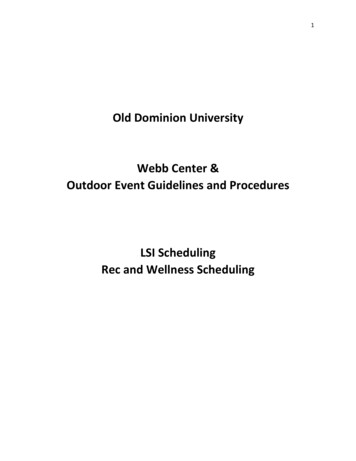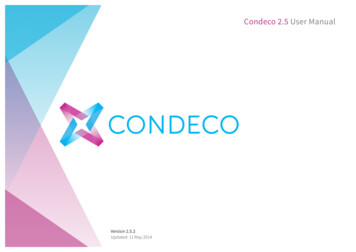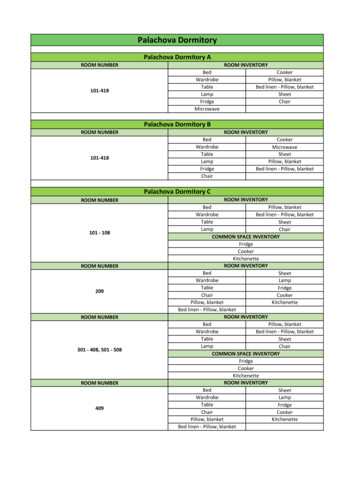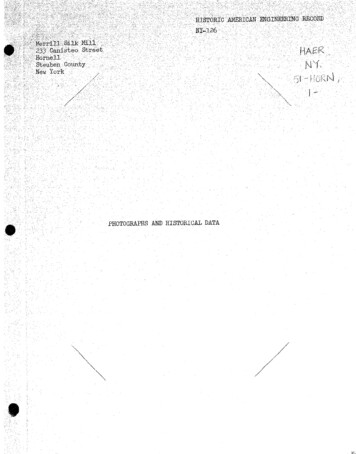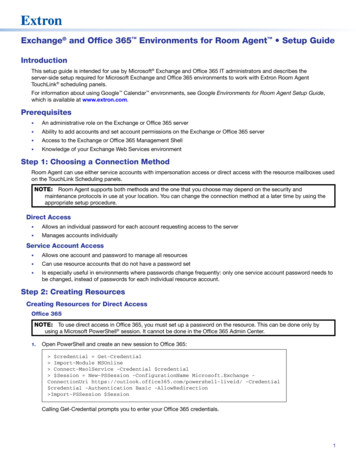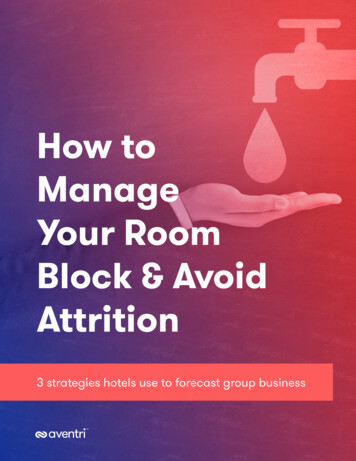
Transcription
How toManageYour RoomBlock & AvoidAttrition3 strategies hotels use to forecast group business
Table of contentsIntroduction3Factors that affect your room block4 The strategies4The blind cut5The cut-off date8AttritionConclusion1218About AventriHowHowto tomanagemanageyouryourroomroomblockblock& avoid& avoidattritionattrition192
1. IntroductionAvoid attrition:successfully manageyour room blockThree strategies hotels use to forecast group business. Noone wants to be stuck paying for something they don’tuse. Gym memberships, a Groupon for the dolphin swim,magazine subscriptions All of these purchases start offwith good intentions. Then what happens? You becometoo busy to hit the gym, forget all about the Groupon, andnever manage to read the magazines.You start off with an idea of what you are going to do, andthen life gets in the way. This can also be true of the groupyou contract. When it comes time to meet the room blockcommitment, there are often many unexpected factorsthat affect the overall pickup. I bet a few of these soundfamiliar The economy: Nothing says under-performance morethan a down economy. Airlines: Grounding, weather, and recently, thereservation system. Layoffs: Companies are still trying to do more with less. Mergers and acquisitions: Some companies areundervalued, others are ready to take over. Budget cuts: Sending less people than the year before. Billy: He’s sick. Daddy can’t attend. Daddy: He’s sick. And he can’t attend. Grandma: She’s sick. And the list goes on you get thepoint.3How to manage your room block & avoid attritionWhen it comestime to meetthe room blockcommitment,there areoften manyunexpectedfactors thataffect theoverall pickup.
Factors that affectyour room blockThe good news is that hotels are familiar with these(and so many more). Most are completely out of yourand the hotel’s control. Knowing how hotels deal withthe uncertainty will help you make better decisions inmanaging your room block.There are three strategies that hotel revenue managersdepend on to help them make the most of their roominventory: Blind Cuts, Cut-off Dates, and Attrition.Let’s take a look behind the curtain and into the hotelrevenue management office to give you a sneak peek athow they manage inventory -- and, more importantly,how it can affect your room block.How to manage your room block & avoid attrition4
2. The strategiesThe blind cutAsking for 100 rooms for three nights? Both you and thehotel want to see that happen just as planned, but thehotel will often hedge its bets a bit and will forecast youractual pickup at 80-85% of your contracted numbers. Thisprocess is known in the industry as a “Blind Cut” becausethat forecast is often not shared with the client. Somehotels may take it a step further and proactively reducethe room block that is committed to your group if they areconcerned that your contracted numbers are too high andnot representative of what you will actually use.How the hotel arrives at the forecasted pickup numbers —and how they decide when and how much to Blind Cut aroom block — is a process that includes a review of yourgroup’s previous meeting history, the type of event, andthe overall demand in the hotel and the city. Hotels havemore data on how room blocks pick up than you’ll everwant to know, and they’re usually right.So what does this mean for yourgroup?Generally nothing, if the hotel isn’t going to sell out. If youneed more rooms than the hotel is forecasting, it will beable to meet those needs. However, if the hotel is very busyover your meeting dates and has your pickup forecastedtoo low, you can save a bunch of pain and get ahead ofany problems by knowing the real room block numbersthat the hotel is actually expecting from your group. Hereare some strategies for managing this conversation withthe hotel.5How to manage your room block & avoid attrition
The blind cut (cont.)What you can do:1.Knowledge is power:Before you sign the contract, ask what the hotelwill be forecasting for your actual pickup. The salesmanager may be surprised to hear that questionfrom you, but gaining an understanding about howthe hotel manages your block after the contract issigned will give you the insight you need to stay ontop of things.2. Set expectations on room block communications:The sooner you can convey your thoughts onyour pickup, the better for both you and the hotel.Although it’s unlikely you’ll have any real indicationof pickup before 30 or 45 days out, you can do somework on your end to help you add confidence. Sendout a quick survey to the potential attendees. Talkwith the meeting owner about their thoughts. And ofcourse, review your meeting history (if the meetinghas been held before).Speaking of history, be sure to share this informationwith the hotel when possible. If the meeting ismandatory and you feel confident the room blockcommitment will be met to the full amount, let thehotel know. Hotels will take this information intoconsideration when forecasting during your meetingdates.How to manage your room block & avoid attrition6
The blind cut (cont.)3. Ask for the hotel forecast:When your event is 60 days away, ask your salesmanager what total occupancy they’re forecastingover your meeting dates. Then have them update youevery other week until your arrival date. Most hotelsactually begin building forecasts months in advance.However, there are still a lot of assumptions in place.If you find that the hotel is forecasting a 90% occupancy on any day over your meeting dates,you’ll want to have a conversation. The conversationcan go two ways: If you feel you’ll meet or exceed your block:Let them know this ASAP. Right now that forecastlikely has you achieving only up to the Blind Cut.Giving the hotel your thoughts on pick-up will helpthem protect your block while better forecastingtheir occupancy. If you’re likely not going to pick up your fullblock: Tell them ASAP. When a hotel forecasts 90%or higher occupancy, they’ll begin to cut downon different channels in order to get the highestrate possible. Letting them know ahead of timewill enable them to keep these channels openlonger and give them an opportunity to sell theguestrooms you will not use.Accurate forecasting is a key way that hotels managetheir inventory and maximize their occupancy. Knowinghow your hotel partners manage that forecastingprocess will help you protect your own block, whileavoiding attrition penalties or possible walks.7How to manage your room block & avoid attritionGiving thehotel yourthoughtson pick-upwill helpthem protectyour blockwhile betterforecastingtheiroccupancy.
The cut-off dateNegotiating your reservation cut-off date is just thebeginning of the process. Learning to effectively manageto it is the real trick.When it comes down to negotiating your hotel contract,few clauses are as impactful to the overall success ofyour event than your reservations clause and cut-offdate. As a refresher, the cut-off date is the date when allof your room reservations must be made. By ”made,”I mean either the date your rooming list is due to thehotel or, if there’s no rooming list, the date when yourattendees must have made their own reservations.Any rooms left unused in your block after this date arereturned to the hotel inventory and put up for generalsale. And often these rooms are sold at a higher rate thanyour negotiated group rate. This becomes a real bummerfor those who procrastinated in making their reservations(which I’m notorious for doing – ugh!).How to manage your room block & avoid attrition8
The cut-off date (cont.)Why do hotelscare about mycut-off date?Before we dive into somekey strategies you can useto better leverage the cutoff date, let’s quickly reviewwhy the date exists in thefirst place.Everything a hotel doesrelating to your room blockis for one purpose: to driveoccupancy. The cut-off dateis no different. By forcinggroups to fill their roomblocks early – hence, thecut-off date – the hotel hasa better shot at managingaround the block to fill asmany rooms as possible.The more time they haveto fill the rooms, the morelikely they’ll actually fillthem.9Strategies youcan use tomitigate theeffect of the cutoff date on yourprogram:The first, of course, is inyour contract negotiations,by working to get thecut-off as close to yourarrival date as possible.The hotel will probablyagree to anywhere froma 30- to a 21-day cut-off,depending on the demand.Less demand means moreflexibility on the cut-offdate. In peak season, youmay find cut-off datesas long as 45 days fromarrival.How to manage your room block & avoid attritionThe key: hoteloccupancyforecastsStart by asking one questionto the hotel reservationsmanager at 90, 60, 45, and30 days out: “What’s yourforecasted occupancy overmy group’s dates?” You see,hotels today have somevery slick technology thatenables them to predict theiroccupancy pretty far out.This is great news for you, asyou’ll be far more effectiveat managing your own blockwith this information. Thehotel’s response will drive allof your decisions from thispoint forward in managingto your cut-off date. Ishould mention here thatif your group is generallygood at timely reservationsor registrations, then youprobably don’t need to readany further. However, if yourattendees are like most,procrastinating all the wayto the end, read on.
The cut-off date (cont.)Here’s how to act depending on what you hear.1. Hotel’s Response: “We’re forecasting 90% [or higher] occupancy.”Anything above 90% means the hotel is yielding their inventory – that is, charging higherrates as the occupancy grows – and will not allow you to have your negotiated rate aftercut-off. Assume the hotel will sell-out, and act accordingly.Steps to take:React now:Communicate to your attendee list immediately. Let them know to get their reservations inby the cut-off date or they’ll likely be out of luck.Track it:Create a simple chart to track the hotel’s occupancy forecast each time you call. Clickhere to download a simple hotel occupancy tracking spreadsheet. This will give you moreinsight into the speed in which reservations are being made and allow you to adjust if,for instance, the hotel is on pace to sell out earlier than expected. Hotels also have toolsavailable to help you track your progress with the room block. Ask them to include thehotel’s forecasted occupancy when sending you the updated pickup report.Pick up the pace:At 45 days out, create a communication plan to get those latecomers to make theirreservations quickly. Maybe offer up a special inventive or do a drawing for those whomake their reservations prior to the cut-off date.How to manage your room block & avoid attrition10
The cut-off date (cont.)2. Hotel’s Response: “We’re forecasting [something less than 90%]occupancy.”Steps to take:Rest easy, but with one eye open:Likely, your cut-off date is now just an exercise to get you to fill the block early. In reality,if you needed more time – in fact up to the day of arrival – you just might get it. A goodpractice during the contract stage is to ask that the guestroom rate be honored afterthe cut-off date, based on hotel’s availability. That way your latecomers are able tomake reservations under the group block and still get the benefit of the great rate younegotiated.Don’t be fooled:Still ask the “What’s your forecasted occupancy over my dates” question at 60 and 45days out from your group’s arrival. Things often change quickly (like a last-minute groupselling out the hotel).The most important thing to remember:By communicating frequently with your hotel, you’ll gain the most control over yourreservation cutoff date. I should add that it’s also critical that you let the hotel know ofany challenges you’re having in filling your blocks. Often they’ll step in to lend a hand,whether by creating marketing pieces for you or even by offering early-bird incentives.No one wakes up in the morning and says, “Gee, I’d loooove to manage my group’sreservation cut-off dates today!” Nevertheless, keeping an eye on the calendar and talkingwith your hotel sales manager 90, 60,45, and 30 days before your event will go a longway to controlling costs and eliminating surprises.11How to manage your room block & avoid attrition
AttritionIt’s a little like the plague: Everyonewants to avoid it.As a refresher, attrition is a term used describe whenyour actual room block pickup is less than what youcontracted – if you don’t “make” your room block, thenyou’re “in attrition.” The term also describes the amountof leeway a hotel offers you if you don’t pick up yourblock – as in, “You have 20% allowable attrition.”You may not think the hotels care about attrition sincethey are still getting paid. However, if you consider theywould much rather have the room occupied by a guestthat is going to spend money in the lobby bar and orderroom service, then you can see why they would like toavoid attrition just as much as you.Hotels have figured out a few different ways to calculateattrition. Let’s talk about the different options.Here are the three key points to keep in mind whennegotiating the allowable attrition clause in the contract: Timeframe Percentage PenaltyProperly setting up the attrition clause in your contractscan save your company thousands if you ever findyourself in a situation where your block isn’t picking upas planned.How to manage your room block & avoid attrition12
Attrition (cont.)1. TimeframeThere are typically two types of timeframe conceptshotels use to help them proactively manageyour room block: The stair-step method and thecumulative method. (Some hotels may use acombination of the two.)Stair-step method:In this method, a hotel lets you gradually reduceyour room block over a series of timeframes. This wasoriginally done to help the hotel better manage theirinventory by asking you to reduce your block furtherout. The clause will look something like this: From contract signing to 90 days out:You can adjust your room block by 10%. From 89 days to 60 days out:You can adjust your block by 8%. From 59 days to 30 days out:You can adjust your block by 5%. Inside 30 days there will no allowable reduction inyour room block.Negotiating the stair-step method:The challenge with this method is that you are beingasked to make a decision on your block further out– when it’s likely you won’t have the necessary datato make an accurate decision. Another problem is itrequires you to remember each date, which if you’reat all like me, requires triple reminders.13How to manage your room block & avoid attrition
Attrition (cont.)1. Timeframe (cont)Minimize the steps:Your goal here is to remove as many steps aspossible, starting with the steps that are furthest out.Looking at the example above, try to get all stepscombined so that you can drop 20% up to 30 daysout.Make the largest reduction as close to arrivalas possible: The example above sets the largestreduction as the earliest decision. That’s great for thehotel but not so great for you. Work to reverse thatso you can reduce the highest percentage when youhave the most information about how your block ispicking up.Cumulative method:This is the simplest and, in most cases, the mostadvantageous to your organization. With thismethod, the calculation occurs after you havechecked out. The hotel adds up your total contractedroom block (including any pre- and post-eventrooms), then subtracts your actual total pickupto determine whether you’re within the allowablepercentage.How to manage your room block & avoid attritionSample clause thatoffers an allowableattrition of 80%:Hotel is relying on,and Group agrees toprovide, a minimum of320 guest roomnights.Should the Group fallbelow this amount,the Group will beresponsible for thedifference between theminimum guest roomnights and actualizedguest room nightsmultiplied by the singleconvention guest roomrate multiplied by 80%(guest room minimumminus guest roomsactualized multiplied bysingle convention roomrate multiplied by 80%),plus any applicabletaxes.14
Attrition (cont.)1. Timeframe (cont)Negotiating the cumulative method:Here are two tips for getting the most out of the hotelwhen you are negotiating this type of clause. Pre- and post-event rooms:In this method, every room night counts. Bevery careful about how many rooms you blockbefore and after the meeting. Depending on yoursituation, you may or may not want your pre/postrooms in the calculation. However, you may wantto ask that forecasting question again. If the hotelis forecasting to sell out during your pre nights,you may run into an issue with attendees trying tomake their reservations, possibly being asked tostay at another hotel for the first night. Discounted rooms:Make sure that all rooms count toward yourpickup. Oftentimes, hotels will remove thediscounted rooms from the calculation. Insist thatall rooms apply.15How to manage your room block & avoid attritionBe verycareful abouthow manyrooms youblock beforeand after themeeting.
Attrition (cont.)2. PercentageThe percentage refers to the amount of your contracted block the hotel will allow youto reduce without penalty. The typical attrition allowance ranges from 15% to 20%.Negotiating the percentage:Pushing for any more than the typical range can be a challenge, as it sends themessage that you don’t have confidence in making your block. Hotels may ask youto reduce your contracted block: “If you’re only looking to commit to 75 rooms [from100 rooms contracted], then let’s bring down the contracted block.” That said, it’s notimpossible, especially if your meeting isn’t happening during peak season. Add a step:If you can manageit, add a step at 60days and ask for theopportunity to reduceby the extra amountthen. The more time yougive hotels to react toreductions, the morelikely they’ll allow it. Themore notice you givethem, the better chancethey have of resellingthe rooms. Agree to reduce spaceaccordingly:For hotels, it’s allabout time and space– meeting space thatis. If you need moreattrition, agree to giveup space at an agreedupon number of daysprior to the event if youfind you need to reduceyour room block. Bespecific on what spaceyou’re willing to give upand when. Remember,for group hotels, theyhave a better chanceof selling guestroomsif they have meetingspace to go along withit.room block management & avoiding attrition Hey wait, I know myblock is going to pickup!Oh, now you’re talking.Too many times plannersdon’t leverage this fortheir benefit. If youknow for sure thatyou’re going to fill yourroom block, then usethis to get some extrastuff. If the hotel offersyou 20% attrition, andyou know you don’tneed it, suggest 10% inexchange for two extrasuite upgrades or aroom rate reduction.16
Attrition (cont.)3. PenaltyNo bones about it, paying for unused rooms is adrag. Hotels hate asking their customers to pay,nearly as much as customers hate paying it. Butthere are things you can do to mitigate the pain,if after all of the shrewd negotiations, you still findyourself in “that place.”Negotiating the penalty clause:Typically hotels will ask for payment equal to thenumber of rooms in penalty, times the room rate.Strategies to mitigate this rely on leveraging yourtotal meeting spend and knowing a little about hotelprofit centers. Base the calculation on rooms profit:Instead calculating the penalty on the whole roomrate, ask for the calculation to be based on profit.Typical rooms profit is 80%, so start there. Do you have a big food and beverage spend?If you know you’re going to exceed your F&Bminimum, leverage that and tie it back to attrition.A sentence like the following can be added toyour attrition clause. “For every dollar in attritionpenalty owed, a credit of 0.50 for every dollarspent in F&B above the minimum F&B will used tooffset the expense.” Ask if they are interested in your next meeting:So you fell short of your room block commitment,but still had an excellent meeting. You loved thehotel and the hotel loved you. Ask if you can applya portion of the paid attrition fees towards a futuremeeting. Typically most hotels will welcome theopportunity to apply 25-50% of the paid feestowards a similar sized meeting.17How to manage your room block & avoid attritionAttrition is anaturally occurringphenomenon in themeetings industry.Block performance iscritical to your abilityto secure hotels in thefuture. Laying out yourstrategy in the contractwill ensure you protectyour company againstunbudgeted expenses,and also againstcreating a historicalfingerprint on yourmeeting, which mayhinder your ability tosecure hotels next time.
3. ConclusionYou are now armed with the knowledge of Blind Cuts,Cut-off Dates, and Attrition. You will be better preparedto deal with any of the unforeseen circumstances thatmight arise during the next meeting. Take the hotels bysurprise and ask the forecasting questions. It will showthem you take your commitments seriously and havetaken the time to understand how the business operates.With a fair amount of knowledge and a bit of luck, youjust might be able to avoid the plague.urgh I meanattrition.See how technology can help you buildgreat hotel meeting requestsaventri.com/GOvenuesourcingHow to manage your room block & avoid attrition18
About AventriAventri is the first true live connection managementplatform. Continually transforming the way eventmanagers execute their events while transforming themarket, Aventri allows clients to create valuable inperson experiences, grow influential communities andexpand brands. The comprehensive integrated solutionstarts with meeting request to venue sourcing, to everycomponent of event management including registration,event marketing solutions, travel management, mobileapps to the all-important “experience” at the event withbadges and onsite solutions. The platform connects eventattendees and drives real-time attendee engagementwhile capturing meaningful data and analytics to helpunderstand an event’s success and provide real-time ROI.19How to manage your room block & avoid attritionContact salesWe're here to helpwith more moneysaving tipssales@aventri.com
3 How to manage your room block & avoid attrition 1. Introduction Avoid attrition: successfully manage your room block Three strategies hotels use to forecast group business. No one wants to be stuck paying for something they don't use. Gym memberships, a Groupon for the dolphin swim, magazine subscriptions All of these purchases start off
